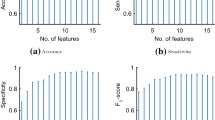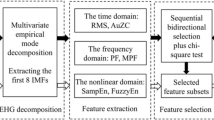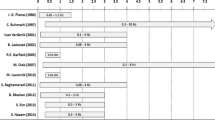Abstract
In this study, we proposed an approach able to predict whether a pregnant woman with contractions would give birth earlier than expected (i.e., before the 37th week of gestation (WG)). It only processes non-invasive electrohysterographic (EHG) signals fully automatically without assistance of an expert or an additional medical system. We used term and preterm EHG signals of 30-minutes duration collected between the 27th and the 32nd WG. Preterm deliveries (< 37W G) had occurred in average 4.00 ± 1.88 weeks since recording dates. Each recording contains three bipolar channels. Using the Huang-Hilbert transform (HHT), we obtained up to twelve intrinsic mode functions (IMFs) for each signal. We found that the most relevant IMFs for both term and preterm records were IMF3 and IMF6. From these two IMFs, we extracted 8 most relevant features targeting EHG signal specificities. We investigated features classifications using support vector machine (SVM) for the 3 single-channels and for all their possible combinations. High discrimination power between term and preterm EHG records was obtained with linear-SVM classifiers. For almost all the cases, mean areas under curves (AUC) exceeded 0.92. A two-channel combination (7 features) achieved the best mean results with A c c u r a c y = 95.70%, S e n s i t i v i t y = 98.40%, S p e c i f i c i t y = 93.00% and A U C = 0.95. Results of the three-channel combination (9 features) were A c c u r a c y = 92.30%, S e n s i t i v i t y = 93.00%, S p e c i f i c i t y = 91.60% and A U C = 0.96. The best single-channel (8 features) gave the mean values: A c c u r a c y = 90.40%, S e n s i t i v i t y = 93.60% and A U C = 0.94. Thus, the advantage of our approach is the high diagnostic performance at low computational cost.














Similar content being viewed by others
References
Acharya, U. R., Sudarshan, V. K., Rong, S. Q., Tan, Z., Lim, C. M., Koh, J. E., Nayak, S., and Bhandary, S. V., Automated detection of premature delivery using empirical mode and wavelet packet decomposition techniques with uterine electromyogram signals. Comput. Biol. Med. 85:33–42, 2017.
Alamedine, D., Khalil, M., and Marque, C., Comparison of different ehg feature selection methods for the detection of preterm labor. Comput. Math. Methods Med. 2013(4):585–593. https://doi.org/10.1155/2013/485684, 2013.
Blanco-Velasco, M., Weng, B., and Barner, K. E., Ecg signal denoising and baseline wander correction based on the empirical mode decomposition. Comput. Biol. Med. 38(1):1–13, 2008.
Chen, L., and Hao, Y., Feature extraction and classification of EHG between pregnancy and labour group using hilbert-huang transform and extreme learning machine. Comput. Math. Methods Med. 2017:1–9. https://doi.org/10.1155/2017/7949507, 2017.
Debnath, L., Recent developments in the wigner-ville distribution and time-frequency signal analysis. Proceedings-Indian National Science Academy Part A 68(1):35–56, 2002.
DeLong, E. R., DeLong, D. M., and Clarke-Pearson, D. L., Comparing the areas under two or more correlated receiver operating characteristic curves: a nonparametric approach. Biometrics 44:837–845, 1988.
Devedeux, D., Marque, C., Mansour, S., Germain, G., and Duchêne, J., Uterine electromyography: a critical review. Am. J. Obstet. Gynecol. 169(6):1636–1653, 1993.
Diab, M. O., El-Merhie, A., El-Halabi, N., and Khoder, L., Classification of uterine emg signals using supervised classification method. J. Biomed. Sci. Eng. 3(9):837, 2010.
Doret, M., Pasquier, J., Gharib, C., and Gaucherand, P., Uterine electromyogram: principle and interest in the diagnosis of preterm labour. J. Gynecol. Obstet. Biol. Reprod. 37(1):24–32, 2008.
Duchene, J., Devedeux, D., Mansour, S., and Marque, C., Analyzing uterine emg: tracking instantaneous burst frequency. IEEE Eng. Med. Biol. Mag. 14(2):125–132, 1995.
Fawcett, T., Roc graphs: Notes and practical considerations for data mining researchers. Copyright HP Co, 2003.
Fele-Żorż, G., Kavṡek, G., Novak-Antoliċ, Ż., and Jager, F., A comparison of various linear and non-linear signal processing techniques to separate uterine emg records of term and pre-term delivery groups. Med. Biol. Eng. Comput. 46(9):911–922, 2008.
Fergus, P., Cheung, P., Hussain, A., Al-Jumeily, D., Dobbins, C., and Iram, S., Prediction of preterm deliveries from ehg signals using machine learning. PloS one 8(10):e77,154, 2013.
Flandrin, P., Gonċalves, P., and Rilling, G., EMD equivalent filter banks, from interpretation to applications. In: Huang, NE and Shen, SSP (Eds.) Hilbert-Huang Transform and Its Applications, chapter 5, pp 57–74. Singapore: World Scientific, 2005.
Fraiwan, L., Predicting preterm delivery based on wavelet packet analysis of a single electrohysterography channel. J. Med. Imaging Health Inf. 6(6):1419–1425, 2016.
Garfield, R. E., Maner, W. L., MacKay, L. B., Schlembach, D., and Saade, G. R., Comparing uterine electromyography activity of antepartum patients versus term labor patients. Am. J. Obstet. Gynecol. 193(1):23–29, 2005.
Goldberger, A. L., Amaral, L. A. N., Glass, L., Hausdorff, J. M., Ivanov, P. C., Mark, R. G., Mietus, J. E., Moody, G. B., Peng, C. K., and Stanley, H. E., PhysioBank, PhysioToolkit, and PhysioNet: Components of a new research resource for complex physiologic signals. Circulation 101(23):e215—e220, 2000. https://doi.org/10.1161/01.CIR.101.23.e215.
Hajian-Tilaki, K., Receiver operating characteristic (roc) curve analysis for medical diagnostic test evaluation. Caspian J. Intern. Med. 4(2):627, 2013.
Hanley, J. A., and McNeil, B. J., The meaning and use of the area under a receiver operating characteristic (roc) curve. Radiology 143(1):29–36, 1982.
Hanley, J. A., and McNeil, B. J., A method of comparing the areas under receiver operating characteristic curves derived from the same cases. Radiology 148(3):839–843, 1983.
Hassan, M., Alexandersson, A., Terrien, J., Karlsson, B., and Marque, C., Wavelet phase synchronization between ehgs at different uterine sites: comparison of pregnancy and labor contractions. In: XII Mediterranean Conference on Medical and Biological Engineering and Computing 2010, Springer, pp 21–24, 2010.
Hassan, M., Boudaoud, S., Terrien, J., Karlsson, B., and Marque, C., Combination of canonical correlation analysis and empirical mode decomposition applied to denoising the labor electrohysterogram. IEEE Trans. Biomed. Eng. 58(9):2441–2447, 2011.
Hassan, M., Terrien, J., Muszynski, C., Alexandersson, A., Marque, C., and Karlsson, B., Better pregnancy monitoring using nonlinear correlation analysis of external uterine electromyography. IEEE Trans. Biomed. Eng. 60(4):1160–1166, 2013.
Huang, N. E., Hilbert-Huang transform and its applications. Vol 16 Singapore: World Scientific, 2014.
Jacod, B. C., Graatsma, E. M., Van Hagen, E., and Visser, G. H., A validation of electrohysterography for uterine activity monitoring during labour. J. Matern. Fetal Neonatal Med. 23(1):17–22, 2010.
de Lau, H., Rabotti, C., Oosterbaan, H. P., Mischi, M., and Oei, G. S., Study protocol: Pope-prediction of preterm delivery by electrohysterography. BMC Pregnancy Childbirth 14(1):192, 2014.
Lucovnik, M., Maner, W. L., Chambliss, L. R., Blumrick, R., Balducci, J., Novak-Antolic, Z., and Garfield, R. E., Noninvasive uterine electromyography for prediction of preterm delivery. Am. J. Obstet. Gynecol. 204(3):228–e1, 2011.
Maner, W. L., Garfield, R. E., Maul, H., Olson, G., and Saade, G., Predicting term and preterm delivery with transabdominal uterine electromyography. Obstet. Gynecol. 101(6):1254–1260, 2003.
Provost, F. J., Fawcett, T., and et al, Analysis and visualization of classifier performance: comparison under imprecise class and cost distributions. In: KDD, Vol. 97, pp. 43–48, 1997.
Ren, P., Yao, S., Li, J., Valdes-Sosa, P. A., and Kendrick, K. M., Improved prediction of preterm delivery using empirical mode decomposition analysis of uterine electromyography signals. PloS one 10(7):e0132,116, 2015.
Rilling, G., Flandrin, P., Goncalves, P., and et al, On empirical mode decomposition and its algorithms. In: IEEE-EURASIP workshop nonlinear signal image process, IEEER, Grado, Italy, Vol. 3, pp. 8–11, 2003.
Terrien, J., Marque, C., and Karlsson, B., Spectral characterization of human ehg frequency components based on the extraction and reconstruction of the ridges in the scalogram, pp. Engineering in Medicine and Biology Society, 2007. EMBS 2007. 29th Annual International Conference of the IEEE, IEEE, pp 1872–1875, 2007.
Vapnik, V., The nature of statistical learning theory. Berlin: Springer science & business media, 2013.
Vrhovec, J., Rudel, D., Pajntar, M., and Lebar, A. M., A uterine electromyographic activity as a measure of labour progression. Zdrav Vestn 79(2), (2010).
Weng, B., and Barner, K. E. Optimal signal reconstruction using the empirical mode decomposition. EURASIP J Adv Signal Process, 2008.
Yan, R., and Gao, R. X., Rotary machine health diagnosis based on empirical mode decomposition. J. Vib. Acoust. 130(2):1–12, 2008.
Zweig, M. H., and Campbell, G., Receiver-operating characteristic (roc) plots: a fundamental evaluation tool in clinical medicine. Clin. Chem. 39(4):561–577, 1993.
Author information
Authors and Affiliations
Corresponding author
Ethics declarations
Conflict of interests
Author N. Sadi-Ahmed declares that she has no conflict of interest. Author B. Kacha declares that she has no conflict of interest. Author H. Taleb declares that he has no conflict of interest. Author M. Kedir-talha declares that she has no conflict of interest.
Ethical approval
This article does not contain any studies with human participants or animals performed by any of the authors.
Additional information
This article is part of the Topical Collection on Image & Signal Processing
Rights and permissions
About this article
Cite this article
Sadi-Ahmed, N., Kacha, B., Taleb, H. et al. Relevant Features Selection for Automatic Prediction of Preterm Deliveries from Pregnancy ElectroHysterograhic (EHG) records. J Med Syst 41, 204 (2017). https://doi.org/10.1007/s10916-017-0847-8
Received:
Accepted:
Published:
DOI: https://doi.org/10.1007/s10916-017-0847-8




